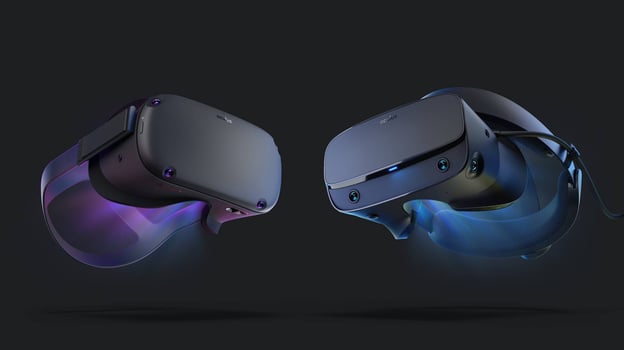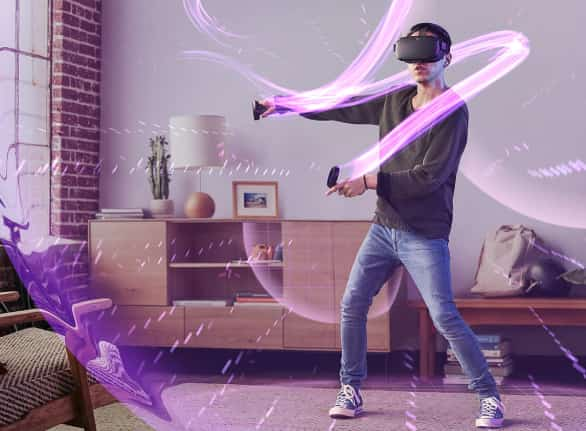2019 has been an incredible year for the VR industry. Ever since the historic release of the Oculus Rift headset in 2017, VR has garnered mass support and adoption by both consumers and Enterprise. Year after year, virtual reality B2C and B2B companies have continued to exceed expectations by delivering far beyond what we thought was humanly possible, and 2019 was no exception.
During late Q1 to early Q2, Oculus released the next iteration of the Oculus Rift (the Rift S) as well as the revolutionary Oculus Quest. While the Rift S promised and delivered higher fidelity and ease of use, the Oculus Quest definitely takes the cake on being the most notable releases of 2019. Not only was the quality of VR comparable to what you would experience on a tethered headset, but because the Quest is a standalone headset, the ability to take a high-quality VR experience with you anywhere you go was truly a technological feat.

The release of both the Quest (left) and Rift S (right) were the major highlight of 2019.
While 2019 was definitely a memorable year for all of us in the VR industry, 2020 seems to be a promising year for everyone in tech. From the latest on 5G technology to greater support in VR content creation, let’s explore some 2020 tech trends that will be sure to stir up the VR industry.
Greater Mobility
With the rise in social media and smart devices, we have become more flexible and interconnected than ever before. This shift is unprecedented, signaling to businesses the inevitable change of placing a greater importance on mobile platforms as well as mobile tools. As businesses continue to seek new ways to connect with a larger audience and extend their reach, the demand for various mobile tools will increase.
While this is a 2020 tech trend applies to all industries and not specifically just to virtual reality applications, this shift impacts the VR industry too.
Ever since the release of the first Oculus standalone headset - the Oculus Go - VR headsets as well as various applications seemed to be shifting towards a greater amount of mobility. While the Go when it was first released was a technological feat in itself, many still remained skeptical whether high-quality mobile VR was possible. Many avid users still preferred tethered headsets since the standalone headset couldn’t compete with how immersive the tethered experience would be.
However, after the release of the highly-anticipated Quest, the tone and direction of where the VR industry is heading to has been solidified. Now you can take with you on the go a truly immersive and high-quality VR experience without needing disassemble and lug around heavy equipment. And while VR was relatively mobile with the Oculus Go, we anticipate 2020 will welcome greater support and applications for the purpose of greater mobility.

Mobility is one trend that will affect the VR industry, especially those who use the technology for business purposes.
Cloud Applications
Many tech hardware companies are still in the process of cracking the code on how to unlock a greater amount of computer processing power. Although it’s no secret that our PC’s have become far more advanced than a decade ago, industries like architecture and interior design still rely heavily on a machine’s ability to perform and process efficiently. And while it beats drawing and designing structures by hand, computers have not advanced to a level where a designer will run into no barriers when completing a project. That’s why there is a greater need for Cloud applications to assist or even revamp the process entirely.
Cloud computing, in its simplest terms, refers to software and services that use the internet instead of your computer. While most people have heard of “The Cloud” in reference to a mode of storing data, it can also be used to process data. And as we wait for computers to become more powerful to match many business people's current processes, Cloud computing will be the most efficient solution to this barrier.
Seeing this trend couldn’t have come at a better time since just a few weeks ago, we launched our brand new Yulio license that comes with unlimited cloud-based rendering capabilities. No longer will you have a preoccupied computer while you wait hours for your rendered image. Depending on the design, you could get your project back in a matter of minutes.
.png?width=1016&name=Yulio%20Jump%20A%20D%20funnel%20-%20Google%20Docs%20(2).png)
Instead of using the SketchUp native renderer (pictured left), transform your project into photorealistic images with Yulio Jump (right rendered with Yulio Jump).
Yulio Jump is now compatible with SketchUp and CET Configura - if you would like to learn more about our cloud-based rendering Yulio license, click here.
The Age of the “New” Internet”
The USA and China are currently head to head to see who can release 5G for mass public use. While both countries have been working on deploying 5G, 2020 will be the year where we get to witness who gets to the finish line first.
5G is the next generation of our greater mobile network. If you currently own a smartphone, chances are you have a phone plan that includes an amount of Megabytes or Gigabytes of data that allows you to surf the net without being connected to the internet. Every generation of our mobile network system improves on the last:
- 1G - the birth of analog voice
- 2G - delivered digital voice (ex. CDMA)
- 3G - the first generation of mobile data (ex. CDMA2000)
- 4G LTE - faster and more efficient mobile Internet
Now, 5G is promising to be bigger and better than before.

It's a race against the clock for the East and the West to deploy 5G for mass consumer use. (Retrieved from: Samsung Newsroom)
“5G is a new kind of network: a platform for innovations that will not only enhance today’s mobile broadband services, but will also expand mobile networks to support a vast diversity of devices and services and connect new industries with improved performance, efficiency, and cost. 5G will redefine a broad range of industries with connected services from retail to education, transportation to entertainment, and everything in between. We see 5G as technology as transformative as the automobile and electricity.”
Qualcomm, 2019 (continue reading here)
While this may not necessarily fit into the mould of a “2020 tech trend”, the implications of this release will be huge for all industries. That includes tech, SaaS, and even specifically VR. And just like mobility gives us a greater ability to connect with clients and prospects all around the world, 5G is the mode that can make the process much smoother than what our current networks can achieve.
2020 - It’s Time to Get Excited
As 2019 has come to a close, it’s time to look forward to all the 2020 tech trends that will be showing up in the VR industry. One theme that we noticed is the greater need and priority for flexibility, efficiency, and having tools that will assist us in connecting with others better. And as we welcome a brand new decade, we are excited to see what 2020 has in store for the VR industry and technology as a whole.
Here at Yulio, we strive for excellence in performance and integrity when it comes to our product, and customer service. To try our program for yourself, sign up for our free 30-day trial (no strings attached). To learn more about how VR can enhance your business workflow, sign up for our FREE 5-day email course.



